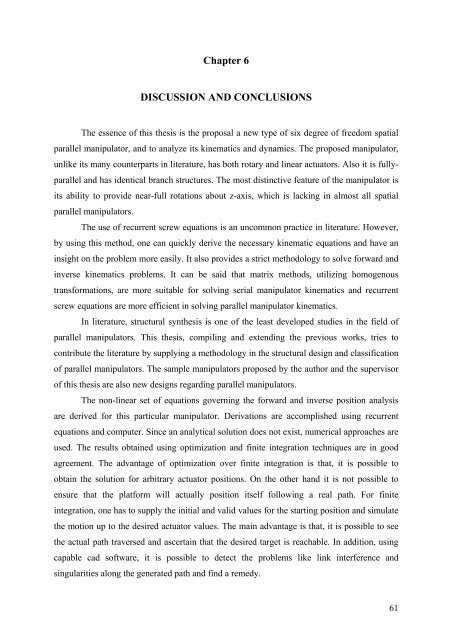Kinematic and Dynamic Analysis of Spatial Six Degree of Freedom ...
Kinematic and Dynamic Analysis of Spatial Six Degree of Freedom ...
Kinematic and Dynamic Analysis of Spatial Six Degree of Freedom ...
You also want an ePaper? Increase the reach of your titles
YUMPU automatically turns print PDFs into web optimized ePapers that Google loves.
Chapter 6<br />
DISCUSSION AND CONCLUSIONS<br />
The essence <strong>of</strong> this thesis is the proposal a new type <strong>of</strong> six degree <strong>of</strong> freedom spatial<br />
parallel manipulator, <strong>and</strong> to analyze its kinematics <strong>and</strong> dynamics. The proposed manipulator,<br />
unlike its many counterparts in literature, has both rotary <strong>and</strong> linear actuators. Also it is fullyparallel<br />
<strong>and</strong> has identical branch structures. The most distinctive feature <strong>of</strong> the manipulator is<br />
its ability to provide near-full rotations about z-axis, which is lacking in almost all spatial<br />
parallel manipulators.<br />
The use <strong>of</strong> recurrent screw equations is an uncommon practice in literature. However,<br />
by using this method, one can quickly derive the necessary kinematic equations <strong>and</strong> have an<br />
insight on the problem more easily. It also provides a strict methodology to solve forward <strong>and</strong><br />
inverse kinematics problems. It can be said that matrix methods, utilizing homogenous<br />
transformations, are more suitable for solving serial manipulator kinematics <strong>and</strong> recurrent<br />
screw equations are more efficient in solving parallel manipulator kinematics.<br />
In literature, structural synthesis is one <strong>of</strong> the least developed studies in the field <strong>of</strong><br />
parallel manipulators. This thesis, compiling <strong>and</strong> extending the previous works, tries to<br />
contribute the literature by supplying a methodology in the structural design <strong>and</strong> classification<br />
<strong>of</strong> parallel manipulators. The sample manipulators proposed by the author <strong>and</strong> the supervisor<br />
<strong>of</strong> this thesis are also new designs regarding parallel manipulators.<br />
The non-linear set <strong>of</strong> equations governing the forward <strong>and</strong> inverse position analysis<br />
are derived for this particular manipulator. Derivations are accomplished using recurrent<br />
equations <strong>and</strong> computer. Since an analytical solution does not exist, numerical approaches are<br />
used. The results obtained using optimization <strong>and</strong> finite integration techniques are in good<br />
agreement. The advantage <strong>of</strong> optimization over finite integration is that, it is possible to<br />
obtain the solution for arbitrary actuator positions. On the other h<strong>and</strong> it is not possible to<br />
ensure that the platform will actually position itself following a real path. For finite<br />
integration, one has to supply the initial <strong>and</strong> valid values for the starting position <strong>and</strong> simulate<br />
the motion up to the desired actuator values. The main advantage is that, it is possible to see<br />
the actual path traversed <strong>and</strong> ascertain that the desired target is reachable. In addition, using<br />
capable cad s<strong>of</strong>tware, it is possible to detect the problems like link interference <strong>and</strong><br />
singularities along the generated path <strong>and</strong> find a remedy.<br />
61
















